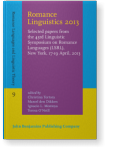Depictive secondary predicates in Spanish and the relative/absolute distinction
This study accounts for the unacceptability of individual-level gradable adjectives as (depictive) secondary predicates on the basis of two factors: (a) the semantics of gradable adjectives—specifically the way their comparison classes are formed in the syntax, giving rise to the difference between relative/absolute adjectives; (b) the pragmatic inference of temporal persistence that characterizes IL predicates. Absolute adjectives are evaluated with respect to a comparison class composed of counterparts (stages) of an individual, so that the property they express must be interpreted as subject to variation. Therefore, the inference of temporal persistence which seems to be at the basis of the individual-level character of predicates does not arise, giving rise to the stage-level interpretation that absolute adjectives receive. The inference of temporal persistence arises by default in the case of relative adjectives since in the comparison class selected by these adjectives there are no stages (of an individual) instantiating different degrees of the property but just different individuals manifesting different degrees of it. The inference of temporal persistence associated with relative adjectives makes the simultaneity constraint required by secondary predication contexts (McNally 1994) trivial and uninformative. As a consequence, only absolute adjectives are allowed in this syntactic environment.
References (33)
References
Ardid-Gumiel, Ana. 2001. “The Syntax of Depictives. Subjects, Modes of Judgement and I-L/S-L Properties.” ZAS Working Papers in Linguistics 26: 61-86.
Asher, Nicholas and Michael Morreau. 1995. “What Generic Sentences Mean.” In The Generic Book, ed. by Gregory Carlson and Francis Jeffry Pelletier, 300-338. Chicago: University of Chicago Press.
Boleda, Gemma, Stefan Evert, Berit Gehrke, and Louise McNally. 2012. “Adjectives as Saturators vs. Modifiers: Statistical Evidence.” In Logic, Language and Meaning, 18th Amsterdam Colloquium, Amsterdam, The Netherlands, December 19-21, 2011, Revised Selected Papers, ed. by Maria Aloni, Vadim Kimmelman, Floris Roelofsen, Galit Sassoon, Katrin Schulz, and Matthijs Westera, 112-121. Dordrecht: Springer.
Bosque, Ignacio. 1990. “Sobre el aspecto en los participios y los adjetivos.” In Tiempo y aspecto en español, ed. by Ignacio Bosque, 177-210. Madrid: Cátedra.
Bowers, John. 1993. “The Syntax of Predication”. Linguistic Inquiry 24 (4): 591-656.
Carrier, Jill and Janet H. Randall. 1992. “The Argument Structure and Syntactic Structure of Resultatives.” Linguistic Inquiry 23: 173-234.
Condoravdi, Cleo. 1992. “Individual-level Predicates in Conditional Clauses.” Talk given at the
LSA Annual Meeting
, Philadelphia, PA.
Corver, Norbert. 1991. “Evidence for DegP.”
Proceedings of NELS
21: 33-47. UMass, Amherst.
Demonte, Violeta and Pascual Masullo. 1999. “La predicación: complementos predicativos.” In Nueva gramática descriptiva de la lengua española, ed. by Ignacio Bosque and Violeta Demonte, Chapter 38. Madrid: Espasa-Calpe.
Demonte, Violeta. 1988. “Remarks on Secondary Predicates: C-command, Extraction, and Reanalysis.” Linguistic Review 6: 1-39. 

Demonte, Violeta. 1992. “Temporal and Aspectual Constraints on Predicative APs.” In Current Studies in Spanish Linguistics, ed. by Héctor Campos and Fernando Martínez-Gil, 165-200. Washington: Georgetown University Press.
Escandell-Vidal, M. Victoria and Manuel Leonetti. 2002. “Coercion and the Stage/Individual Distinction.” In From Words to Discourse. Trends in Spanish Semantics and Pragmatics, ed. by Javier Gutiérrez Rexach, 159-180. Oxford: Elsevier.
Fults, Scott. 2006. The Structure of Comparison: An Investigation of Gradable Adjectives. PhD Dissertation, University of Maryland.
Gumiel-Molina, Silvia, Norberto Moreno-Quibén, and Isabel Pérez Jiménez. 2015. “Comparison classes and the relative/absolute distinction: A degree-based compositional account of the ser/estar alternation in spanish.” B. Gehrke E. Castroviejo (Eds) Degree and manner modification across categories, special volume of Natural Language and Linguistic Theory. 

Gumiel-Molina, Silvia. 2008. Estructura argumental y predicación secundaria. Alcalá de Henares: Servicio de publicaciones de la UAH.
Hernanz, M. Lluïsa. 1988. “En torno a la sintaxis y la semántica de los complementos predicativos en español.” Estudis de Sintaxi, Estudi General 8: 7-29.
Jiménez, Ángel. 2000. “Minimalismo, aspecto y predicados secundarios.” Phiologia Hispalensis 12: 161-170.
Kennedy, Christopher. 1999. Projecting the Adjective: the Syntax and Semantics of Gradability and Comparison. Outstanding dissertations in Linguistics. New York: Garland.
Kennedy, Christopher. 2007. “Vagueness and Grammar: the Semantics of Relative and Absolute Gradable Adjectives.” Linguistics and Philosophy 30 (1): 1-45. 

Kennedy, Cristopher and Louise McNally. 2005. “Scale Structure, Degree Modification, and the Semantics of Gradable Predicates.” Language 81: 345-381. 

Leonetti, Manuel and Victoria Escandell-Vidal. 1991. “Secondary Predication inside DPs.” University of Venice Working Papers in Linguistics I/7: 1-35.
Magri, Giorgio. 2009. “A Theory of Individual-level Predicates Based on Blind Mandatory Scalar Implicatures.” Natural Language Semantics 17 (3): 245-297. 

Mallén, Enrique. 1991. “A Syntactic Analysis of Secondary Predication in Spanish.” Journal of Linguistics 27: 375-403. 

Marín, Rafael. 2001. El componente aspectual de la predicación. Doctoral Dissertation, Universidad Autónoma de Barcelona.
McNally, Louise. 1994. “Adjunct Predicates and the Individual/Stage Distinction.” Proceedings of WCCFL vol. 12: 561-576. 
McNally, Louise. 1998. “Stativity and Theticity.” In Events and Grammar, ed. by Susan Rothstein, 293-308. Dordrecht: Kluwer. 

Percus, Orin J. 1997. Aspects of A. PhD Dissertation, MIT.
Rapoport, Tova R. 1999. “Structure, Aspect and the Predicate.” Language 75 (4): 653-677. 

Rothstein, Susan. 1983. The Syntactic Forms of Predication. PhD Dissertation, MIT.
Rothstein, Susan. 2011. “Secondary Predicates.” In Semantics: An International Handbook of Natural Language Meaning (Vol. 2), ed. by Klaus von Heusinger, Claudia Mainborn, Paul Portner, 1142-1662. Berlin: Mouton de Gruyter.
Sassoon, Galit W. 2013. Vagueness, Gradability and Typicality: the Interpretation of Adjective and Nouns. Leiden-Boston: Brill. 

Toledo, Assaf and Galit W. Sassoon. 2011. “Absolute vs. Relative Adjectives - Variance Within vs. Between Individuals.” Proceedings of SALT 21: 135-154. 

Cited by (1)
Cited by one other publication
Escandell-Vidal, M. Victoria
2023.
Estar+ILP.
Spanish in Context 20:2
► pp. 257 ff.

This list is based on CrossRef data as of 25 july 2024. Please note that it may not be complete. Sources presented here have been supplied by the respective publishers.
Any errors therein should be reported to them.
